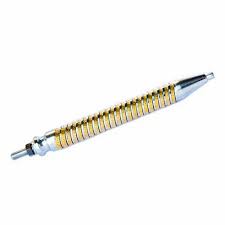
The main function of temple parts is to maintain consistent fabric width and tension throughout the weaving process. As the fabric is woven, the warp threads (the longitudinal threads) may naturally stretch or contract, which can lead to variations in the fabric's width and overall tension. The temple helps prevent this by exerting pressure on the fabric as it passes through the loom, ensuring that it remains at a uniform width. This is particularly important in fabrics like denim or upholstery, where the integrity of the fabric’s width is essential for maintaining a consistent product.
Temple parts typically include components like temple rollers, temple arms, and tensioning mechanisms, all of which play a critical role in ensuring the fabric’s stability. Temple rollers are the primary components that apply pressure to the fabric, helping to maintain its tension and prevent distortion. The temple arms provide support to the rollers and allow them to be adjusted to accommodate different fabric widths. These arms also help to ensure that the fabric passes through the loom smoothly. Tensioning mechanisms help control the amount of pressure applied to the fabric, preventing it from becoming either too loose or too tight, which could result in defects.
Another important feature of temple parts is their ability to adjust to different fabric types. Weaving different materials, such as cotton, polyester, or wool, requires varying levels of pressure and tension. Temple parts are often adjustable to accommodate these different fabric characteristics, ensuring that the weaving process runs smoothly without any interruptions. Whether dealing with delicate fabrics or heavier materials, the flexibility of temple parts allows for better adaptability and improved fabric quality.
In addition to their primary function of controlling fabric width and tension, temple parts also contribute to the overall efficiency of the weaving process. By maintaining the fabric’s consistency throughout the weaving operation, temple parts help reduce the number of defects and minimize fabric wastage. They also ensure that the fabric is evenly processed, which is essential when the fabric is cut, dyed, or further finished. Regular maintenance of temple parts, such as cleaning the rollers, lubricating moving parts, and checking for wear and tear, is necessary to keep them functioning optimally and avoid disruptions in the weaving process.
In summary, temple parts are indispensable in the weaving industry, providing the necessary tension and width control to ensure high-quality fabric production. They maintain fabric integrity, prevent defects, and increase production efficiency. With proper maintenance, temple parts can contribute to consistent output and minimal fabric wastage, ensuring that the final product meets the required standards of quality and durability.
We Hope You Find What You are Looking for
Temple parts are essential components in the textile industry, primarily used in weaving machines to maintain the correct width and tension of the fabric during the weaving process. These parts are crucial for ensuring that the fabric remains smooth, consistent, and free from defects caused by irregular tension or width distortion. Temple parts work to prevent the fabric from becoming too tight or too loose as it is woven, ensuring high-quality production with minimal defects.
Frequently Asked Questions






